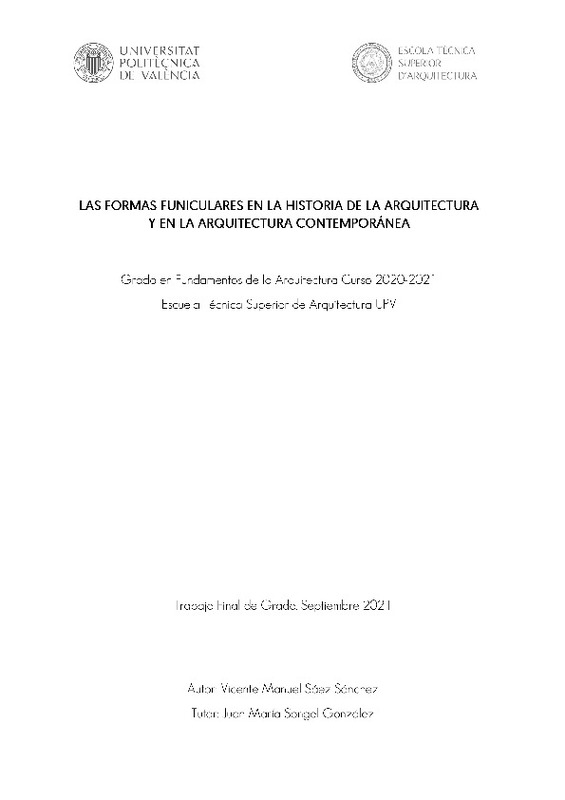JavaScript is disabled for your browser. Some features of this site may not work without it.
Buscar en RiuNet
Listar
Mi cuenta
Estadísticas
Ayuda RiuNet
Admin. UPV
Las formas funiculares en la historia de la arquitectura y en la arquitectura contemporánea.
Mostrar el registro sencillo del ítem
Ficheros en el ítem
| dc.contributor.advisor | Songel Gonzalez, Juan María
|
es_ES |
| dc.contributor.author | Sáez Sánchez, Vicente Manuel
|
es_ES |
| dc.date.accessioned | 2021-12-21T11:56:36Z | |
| dc.date.available | 2021-12-21T11:56:36Z | |
| dc.date.created | 2021-09-30 | |
| dc.date.issued | 2021-12-21 | es_ES |
| dc.identifier.uri | http://hdl.handle.net/10251/178701 | |
| dc.description.abstract | [ES] En el presente trabajo se analizan los principales avances sobre las formas funiculares aplicadas a la arquitectura desde que Robert Hooke planteara la catenaria como la forma ideal que debería tener un arco que sustenta su propio peso, así como los factores que motivaron su uso o, por el contrario, el hecho de optar por otras alternativas menos óptimas. Todo esto, apoyándonos en diferentes autores y obras, desde Christopher Wren hasta Heinz Isler pasando por Antonio Gaudí y sus discípulos, como Cèsar Martinell, para finalmente analizar la situación actual, la proyección que tienen estas geometrías a día de hoy y las posibilidades que pueden ofrecernos de cara al futuro de la arquitectura y la relación del ejercicio de esta atendiendo a la delicada situación en la que se encuentra nuestro planeta. Para esto último nos centraremos principalmente en las figuras de Peter Rich, arquitecto de un gran valor social que actúa mayormente en territorio africano, y del Block Research Group, encabezado por el arquitecto Philippe Block, grupo que puede orientar el camino hacia una construcción futura más limpia y eficiente haciendo uso de estas formas. | es_ES |
| dc.description.abstract | [EN] This paper analyzes the main advances on funicular forms applied to architecture since Robert Hooke proposed the catenary as the ideal form that should have an arch that supports its own weight, as well as the factors that motivated its use or, otherwise, to choose other less optimal alternatives. All this, relying on different authors and works, from Christopher Wren to Heinz Isler through Antonio Gaudí and his disciples, such as Cèsar Martinell, to finally analyze the current situation, the projection that these geometries have today and the possibilities they can bring us for the future of architecture taking into account the delicate situation which our world is suffering. For the latter part we will focus mainly on the figures of Peter Rich, an architect of great social value who works mainly in Africa, and the Block Research Group, led by architect Philippe Block, a group that can guide the way to a cleaner and more efficient future construction using these forms. | es_ES |
| dc.format.extent | 83 | es_ES |
| dc.language | Español | es_ES |
| dc.publisher | Universitat Politècnica de València | es_ES |
| dc.rights | Reconocimiento - No comercial (by-nc) | es_ES |
| dc.subject | Arco | es_ES |
| dc.subject | Formas Funiculares | es_ES |
| dc.subject | Catenaria | es_ES |
| dc.subject | Equilibrio | es_ES |
| dc.subject | Estructuras Ligeras | es_ES |
| dc.subject | Arquitectura | es_ES |
| dc.subject | Arch | es_ES |
| dc.subject | Funicular Forms | es_ES |
| dc.subject | Catenary | es_ES |
| dc.subject | Equilibrium | es_ES |
| dc.subject | Light Structures | es_ES |
| dc.subject | Architecture | es_ES |
| dc.subject.classification | COMPOSICION ARQUITECTONICA | es_ES |
| dc.subject.other | Grado en Fundamentos de la Arquitectura-Grau en Fonaments de l'Arquitectura | es_ES |
| dc.title | Las formas funiculares en la historia de la arquitectura y en la arquitectura contemporánea. | es_ES |
| dc.type | Proyecto/Trabajo fin de carrera/grado | es_ES |
| dc.rights.accessRights | Abierto | es_ES |
| dc.description.bibliographicCitation | Sáez Sánchez, VM. (2021). Las formas funiculares en la historia de la arquitectura y en la arquitectura contemporánea. Universitat Politècnica de València. http://hdl.handle.net/10251/178701 | es_ES |
| dc.description.accrualMethod | TFGM | es_ES |
| dc.relation.pasarela | TFGM\57640 | es_ES |
Este ítem aparece en la(s) siguiente(s) colección(ones)
-
ETSA - Trabajos académicos [4698]
Escuela Técnica Superior de Arquitectura






